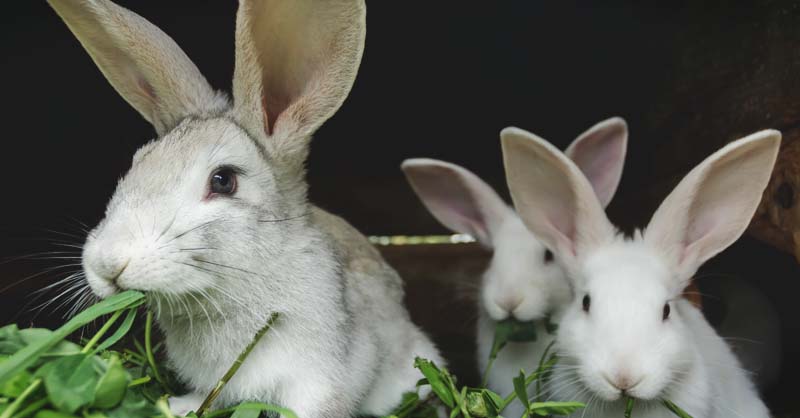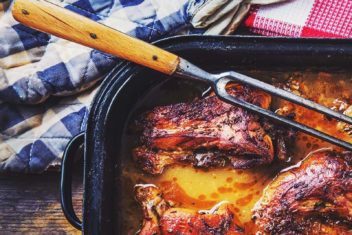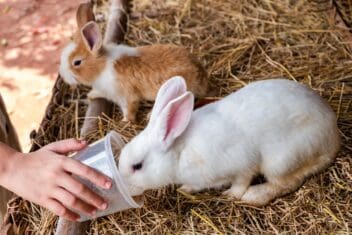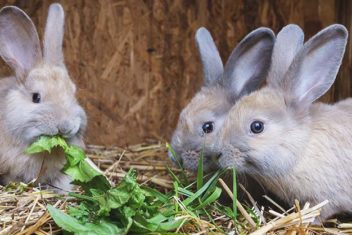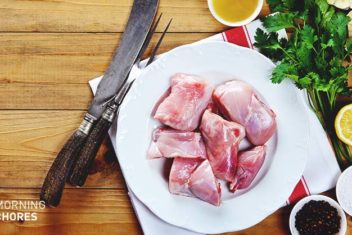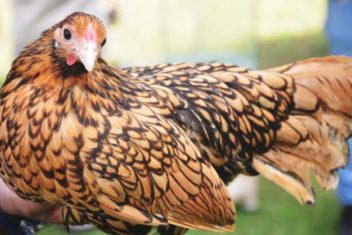If you are new to animal husbandry and looking to get started with something small and easy, then raising rabbits for profit is a no-brainer.
Rabbits are versatile critters to raise on your homestead; they are easy to care for, reasonably inexpensive to raise, and of course, they reproduce quickly.
Aside from their adorably twitchy noses, rabbits can turn a profit… in a lot of different ways.
While one income stream may not add up to a profit to brag about, combining all of the following might just be a new business endeavor for you.
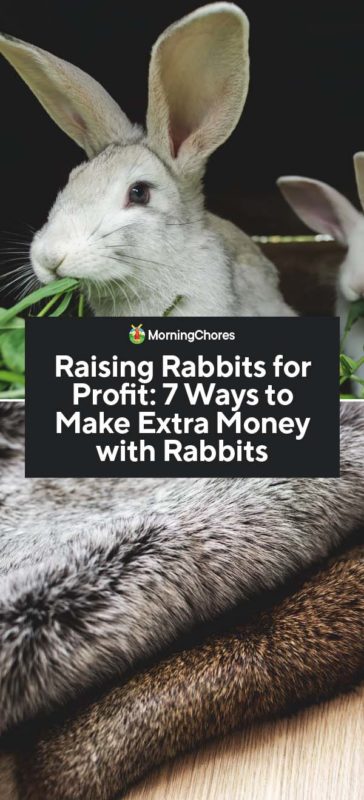
1. Selling Rabbit Meat
Rabbit meat is widely popular meat throughout many different cultures of the world. However, in the United States, it has not gained the popularity it deserves.
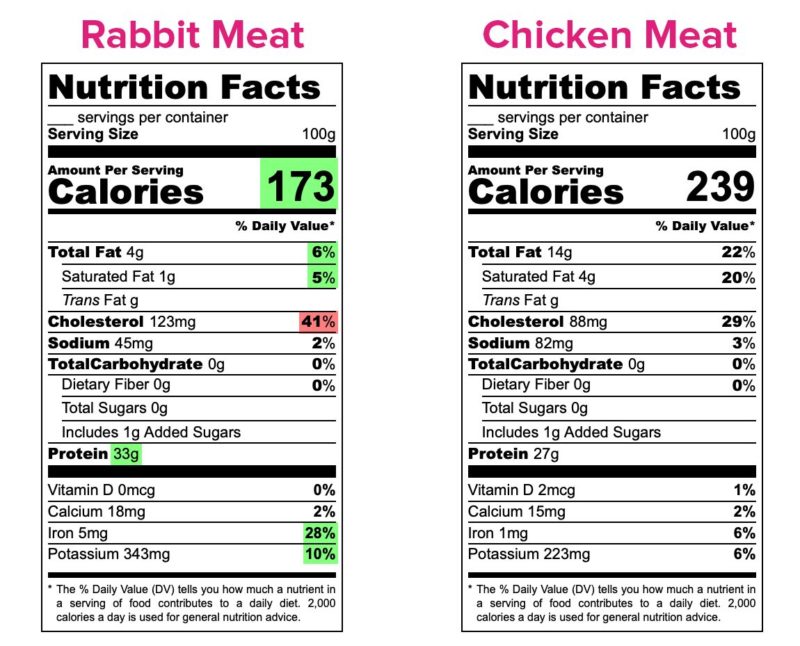
The white meat, produced by rabbit, is exceptionally lean. It has lower calories, lower fat, and higher protein. The only downside is that rabbit meat has higher cholesterol which may not be good if you have cardiovascular disease.
Rabbit meat tastes very similar to chicken, with a bit of a stronger flavor–not too much though. But don’t take our word for it, try these rabbit recipes to see for yourself.
So, if you are looking to eat healthier meat, you should consider rabbit–not to mention you can swap out chicken meat for rabbit meat in almost any recipe.
With that being said, it can be challenging to find rabbit meat in local restaurants and grocery stores unless they are higher-end establishments.
Raising rabbits for meat is quite a simple production to start if you have the time and space. It can be highly lucrative, especially if you plan to raise your rabbits on grass and market your product as grass-fed rather than as raised in hutches.
Where to Process Your Meat Rabbits:
Once your rabbits are old enough for processing, usually around 12 weeks, you will need to process them in accordance with any regulations you may have in your county.
Rabbits are considered “poultry” in most meat processing situations, so many of the rules that apply to chickens apply to rabbits. However, you might have to dig around and ask a ton of questions about what’s ok, and what is going to get you fined.
Two ways to process your rabbits are
- Yourself on your farm – See How to Butcher a Rabbit
- At a USDA-inspected facility
Where you process your rabbits will depend on how many rabbits you expect to process and where you will be selling the rabbit meat.
Who To Sell Your Rabbit Meat To:
Once your meat is processed, you should get it to the consumer as soon as possible. Here’s a list of ideas on where you can sell your rabbit meat:
- Friends and family
- Farmer’s markets
- High-end or local restaurants
- Grocery stores
- Online (lots of extra red tape here since you may be selling across state lines)
- Owner of dogs that consume raw dog food
- Commercial dog food companies
Potential Profit:
Rabbit is considered a delicacy, and the price you can get per pound certainly reflects that.
You can probably ask about $6 per lb for your rabbit meat. It doesn’t matter if you sell it for human consumption or dog food. Rabbit is in high demand, so you can ask what it’s worth…and probably get it.
2. Selling Rabbit Pelts
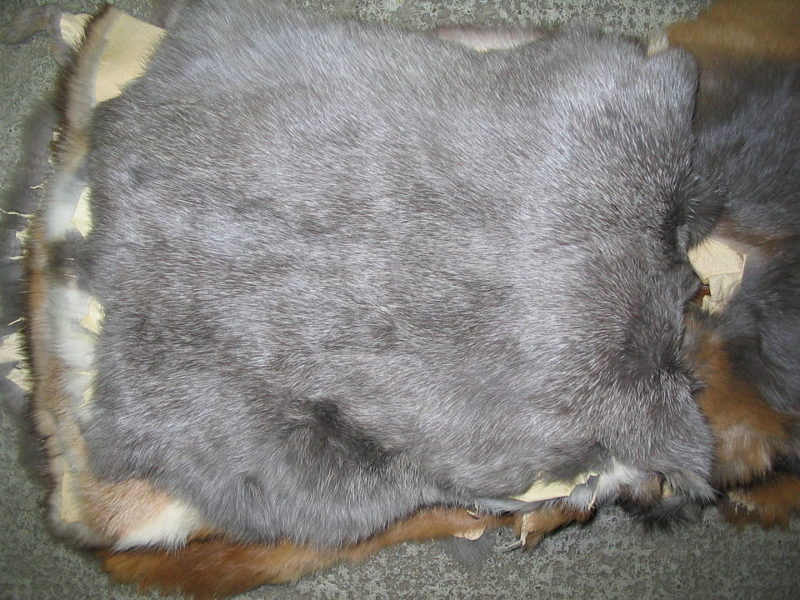
Naturally, after you’ve processed a rabbit for meat, the hide is a byproduct, if you will. Instead of discarding this part of the rabbit, you can turn it into something beautiful that many crafters would love to have in their studio.
Rabbit pelts are often used to make clothes, dolls, and other goodies. If you are artistic, you can create your own masterpieces and sell them to consumers.
Tanning rabbit hides can be a longterm process, but with care and practice, it can become easier to complete. You can learn to prepare the pelt yourself or hire someone to do this for you–just remember, outsourcing will cut into your profit margin!
Who To Sell Rabbit Pelts To:
- Commercial Industry
- Homesteaders
- Crafters
Potential Profit:
Now, I never said that you’d make a ton of money with your rabbit pelts, and some prefer to toss the byproduct rather than try to market and sell it.
Rabbit pelts can bring in anywhere from $1.50 to $30.00 per pelt. What you get for your hide will depend on varying factors like:
- Breed of Rabbit
- Age of Rabbit
- Tanner’s Skill
- Color of Fur
- Size of Pelt
- Other preparation factors (dyed, patterned, etc.)
3. Selling Rabbit Fur as Fiber

Rabbit fur is a luxury item for crafters and commercial operations that want to produce a soft, silky, product.
Instead of the entire tanned hide, rabbit fur is sheared, or hand-plucked, from long-haired rabbits, such as the Angora Rabbit.
If you want to make a profit from rabbits, but don’t have the heart to use them for meat, you could start shearing your pet Angora rabbits and make a few bucks on this luxury fiber.
In general, raising rabbits is a reasonably easy task for those interested in animal husbandry; however, the Angora rabbit requires a little more TLC than a New Zealand rabbit (which is typically raised for meat).
If you want beautiful fiber, you are going to have to tend to it, almost daily. Long-haired rabbit breeds have a tendency to become matted if not cared for properly, and this can be painful for the rabbit and increase risk of disease and parasites.
Who to Sell Rabbit Fiber To:
- Etsy
- Flea Markets
- Crafters
- Knitters, Fiber Artists, Spinners
- Woolen Mills
- Yarn Shops
Potential Profit:
You can sell Angora fiber for about $7 per ounce, all the way up to $16 or more. Again, there are a few factors that will determine what you can charge, and what consumers are willing to pay. Factors like:
- Hand-plucking (better than shearing!)
- Breed of rabbit
- Age of rabbit
- Color of Fur
4. Selling Ready-to-Use Fertilizer with Rabbit Manure
Rabbit manure is a superpowered fertilizer because it is rich in nitrogen and can be applied directly to plants without the risk of burning the vegetation.
So, instead of having to wait months to use fertilizer from other animals, nutrient-rich rabbit manure can be used right away!
Who to Sell Rabbit Manure To:
- Gardeners
- Hobby Farmers
- Landscaping Companies
Potential Profit:
I’ve seen rabbit manure go from $0 to $45 for a 40lb bag. Now, some people will pay more if the manure has been aged, or composted with worms (see below). It also depends on your location and supply and demand.
So, while most give it away for free because they just want to be rid of it, others are making a killing on their rabbit’s poop (the $45 price tag is NOT the norm).
5. Build a Worm Farm with Rabbit Manure
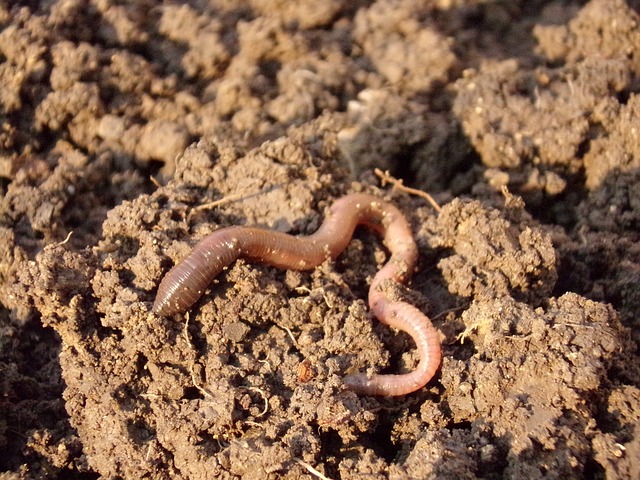
If you are looking to get every last ounce of use from your rabbitry operation, you can add worms to the mix.
Yup, you can use worms and vermicomposting not only to help compost manure and keep odors down but also as another potential income stream.
Who to Sell Worms To:
Because you will be using worms like nightcrawlers, you can them to:
- Fishermen
- Bait Shops
- People who utilize composting bins
Potential Profit:
I bet you never thought you could make some extra cash collecting worms from your manure pile, but it’s true!
You can sell earthworms, nightcrawlers, for about $31 per pound. Remember though, worms don’t weigh a lot, so getting a pound of wrigglers might take some time…and a lot of poop.
If you fish, you know that worms aren’t cheap. Many bait shops will charge $2 a dozen, and so can you.
6. Selling Rabbits As Pets

You can always sell your rabbits as breeders or pets to those who just want a fluffy bunny to spend their time with.
You can check with local pet stores to see if they are looking for a regular supplier of bunnies… just remember, pet stores need to make a profit on your buns, so they will not expect to have to pay more than $15 per bunny.
Plus, pet stores don’t typically care what breed your rabbit is (mixed or purebred), so it’s not going to matter if your Flemish Giant won first place at the local fair and her babies are worth $80. They’ll want to give you $10.
On the other hand, if you plan your marketing right (cough cough, easter and fair time), you can sell your live rabbits for anywhere from $20 to $100 depending on the purpose and quality of your stock.
4-H’ers are a great customer because they want to learn animal husbandry and buy the winning rabbit. And I promise you, no matter how much money you make with your rabbits, seeing a child chose their new pet is absolutely priceless.
7. Selling Pinkies
This income stream may make you feel a little squeamish, but if you want to add another one to your list, you can consider selling newborn kits to snake owners and pet stores.
You don’t have to take live kits to the pet store if you don’t want to; you can just sell those that didn’t survive from your most recent kindling (litter of rabbits).
Often, in a large rabbitry, there will be stillborns and does that do not care for their young. Overly large litters often suffer because does do not have enough milk for their whole kindling.
When you notice a lifeless kit, as long as it has not been dead for a long time, you can freeze them, and sell them once you have enough…but be sure to check frequently because no one wants a rotten pinkie.
Who to Sell Pinkies To:
- Snake Owners
- Pet shops
Potential Profit:
About $3 per pinkie.
By now you should realize that raising rabbits for profit does have a lot of options. And you could even combine a few and generate multiple income streams. Who can say no to that?
So, if you are keen to get started, do your homework first and view our rabbit hutch plans to see which would suit you. Study up on our rabbit care guide, and know the most common types of rabbit diseases before raising rabbits for profit.
